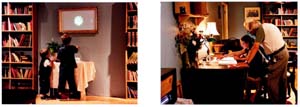| 2004 |

|
YEAR BOOK |
University of Limerick
|
Designing novel interactive spaces through ubiquitous technologies
|
'Re-Tracing the Past' was an interactive museum exhibition developed thanks to these technologies by IDC researchers, in collaboration with a team of European partners within the EU SHAPE Project. The exhibition was held at the Hunt Museum in June 2003 and its goal was to implement novel, 'invisible' technologies to support the exhibits without interfering with the Museum's existing fittings.

The exhibition was a fully interactive environment: exploring the space and its elements allowed visitors to discover the secrets of some of the mysterious objects in the Hunt collection�.but also gave them a chance to contribute to the exhibition: visitors could, in fact, record their opinions on the objects and leave a trace of their visit.
The exhibition was extremely successful, featuring nearly a thousand visitors over ten days, and provided IDC researchers with useful insights for future work: within a recently funded Science Foundation Ireland project, Shared Worlds, novel interactive installations in public spaces will be developed over the next four years at a number of locations around Ireland.
Contact: Luigina Ciolfi, Interaction Design Centre, Computer Science Building, Room CS2034, University of Limerick;
Tel: [+353] 061 213530; Fax: [+353] 061 202734; E-mail: [email protected]